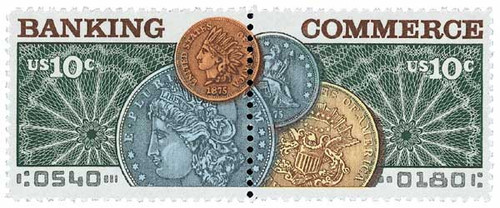
# 1577 - 1975 10c Banking and Commerce: Silver Dollar
Banking and Commerce Issue
Establishment Of The U.S. Mint
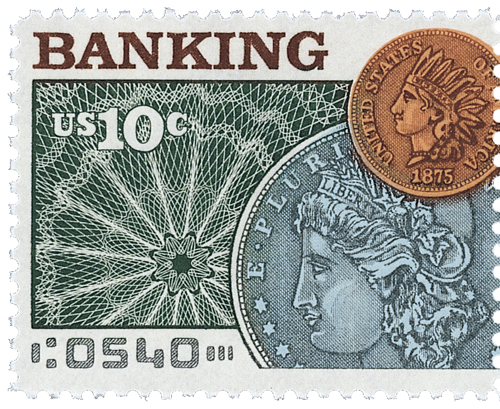
On April 2, 1792, Congress passed the Coinage Act, also known as the Mint Act, which among other things, created the United States Mint.
In colonial America, settlers were expected to follow the rules set by the king of England. While a few charters allowed colonies to produce their own coins, most did not. Then in 1652, the people of the Massachusetts Bay Colony took a chance when England was without a king and established their own mint in Boston.  Though a new king later came to power, the Boston Mint struck all its coins for 30 years with a 1652 date, to lead the British to believe all those coins had been minted then.
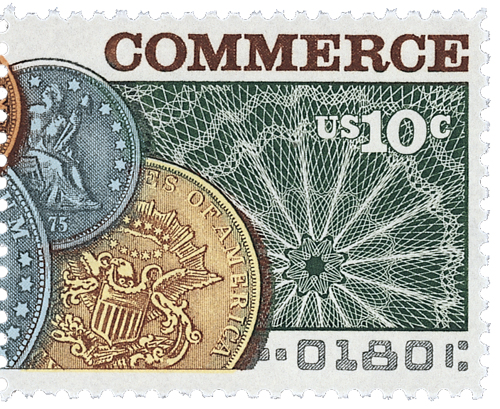
A century later, as America went to war with England for its independence, the issue of coin production arose again. In February 1777, a congressional committee suggested the creation of a national mint in America. While the Treasury Board was supposed to begin planning a mint, they took no further action. However, this was the first known instance of Congress’ interest in creating a national mint.
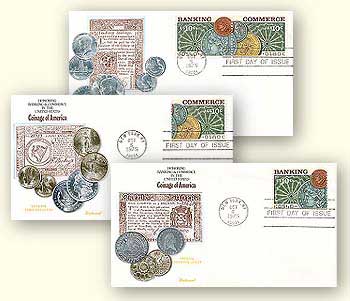
The following year, the Articles of Confederation authorized the states to strike their own coins. That same year, a committee designed the Treasury seal, which is used on US money and is part of the Mint seal.
Then in 1782, the Superintendent of Finance Robert Morris addressed Congress, asking to establish a US mint, with the production costs to be paid by those that used the coins. Four years later, the Continental Congress authorized the establishment of a mint but stated that coins should be produced on contract rather than at the expense of the public.
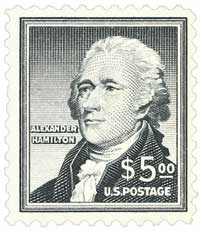
However, in 1789, the new Constitution went into effect, replacing the Articles of Confederation. Under the Constitution, Congress was given the power to make money, regulate its value, and punish counterfeiters. It also prohibited the states from producing their own money. Two years later, Secretary of the Treasury Alexander Hamilton submitted a report to Congress suggesting a mint. Congress responded and produced a resolution in March 1791. A little over a year later, the resolution became law on April 2, 1792. It authorized the creation of national mint “at the seat of the government of the United States.â€Â The US Mint building in Philadelphia was the first Federal building created under the Constitution.
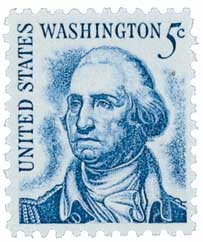
The act called for the Mint to make coins of gold, silver, and copper. The first coins struck were half dimes reportedly made from silverware donated by George and Martha Washington. The first coins to be struck and circulated were 11,178 copper cents delivered on March 3, 1793. Sometimes called the chain cent, it was unpopular with the public because the chain of 15 links on the back (meant to symbolize the states) reminded many of slavery. It was quickly replaced with the wreath cent, which you can view here.
Click here to read the full text of the Coinage Act of 1792 and here for more history on the US Mint.
Â
Banking and Commerce Issue
Establishment Of The U.S. Mint

On April 2, 1792, Congress passed the Coinage Act, also known as the Mint Act, which among other things, created the United States Mint.
In colonial America, settlers were expected to follow the rules set by the king of England. While a few charters allowed colonies to produce their own coins, most did not. Then in 1652, the people of the Massachusetts Bay Colony took a chance when England was without a king and established their own mint in Boston.  Though a new king later came to power, the Boston Mint struck all its coins for 30 years with a 1652 date, to lead the British to believe all those coins had been minted then.

A century later, as America went to war with England for its independence, the issue of coin production arose again. In February 1777, a congressional committee suggested the creation of a national mint in America. While the Treasury Board was supposed to begin planning a mint, they took no further action. However, this was the first known instance of Congress’ interest in creating a national mint.

The following year, the Articles of Confederation authorized the states to strike their own coins. That same year, a committee designed the Treasury seal, which is used on US money and is part of the Mint seal.
Then in 1782, the Superintendent of Finance Robert Morris addressed Congress, asking to establish a US mint, with the production costs to be paid by those that used the coins. Four years later, the Continental Congress authorized the establishment of a mint but stated that coins should be produced on contract rather than at the expense of the public.

However, in 1789, the new Constitution went into effect, replacing the Articles of Confederation. Under the Constitution, Congress was given the power to make money, regulate its value, and punish counterfeiters. It also prohibited the states from producing their own money. Two years later, Secretary of the Treasury Alexander Hamilton submitted a report to Congress suggesting a mint. Congress responded and produced a resolution in March 1791. A little over a year later, the resolution became law on April 2, 1792. It authorized the creation of national mint “at the seat of the government of the United States.â€Â The US Mint building in Philadelphia was the first Federal building created under the Constitution.

The act called for the Mint to make coins of gold, silver, and copper. The first coins struck were half dimes reportedly made from silverware donated by George and Martha Washington. The first coins to be struck and circulated were 11,178 copper cents delivered on March 3, 1793. Sometimes called the chain cent, it was unpopular with the public because the chain of 15 links on the back (meant to symbolize the states) reminded many of slavery. It was quickly replaced with the wreath cent, which you can view here.
Click here to read the full text of the Coinage Act of 1792 and here for more history on the US Mint.
Â








